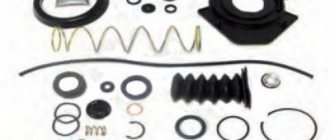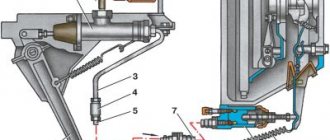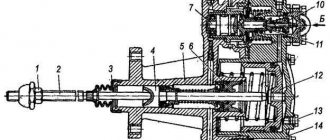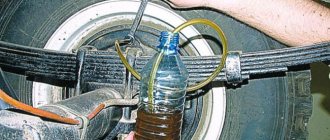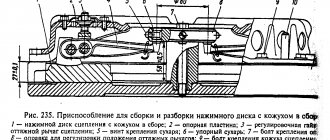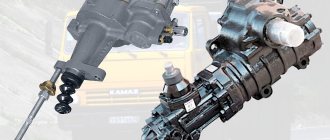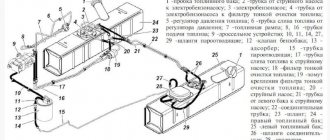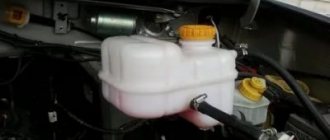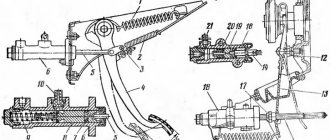Bleeding the clutch, as well as the brakes, on the UAZ “Loaf” is not a very common procedure. Although it does not require any special tools or skills, car enthusiasts often ignore this procedure during regular inspection of their van. But in vain. After all, removing air from the hydraulic system, which necessarily gets there after replacing the working fluid or reinstalling components, is necessary for the proper operation of the mechanism.
How to bleed the clutch of a UAZ Bukhanka
How to pump the clutch yourself Good day, dear motorists!
The technological operation of bleeding the clutch is a relatively rare thing. Actually, like bleeding the brake system. And according to the algorithm for bleeding the clutch, it is not much different from bleeding the brakes yourself. Yes, do it yourself, since bleeding the clutch will not take much of your time and will not require highly qualified car mechanics. Therefore, without delaying it, let’s learn the theory of how to bleed the clutch of your car.
Do-it-yourself clutch bleeding: features
Firstly, when is clutch bleeding necessary? To be precise, the operation is called: removing air from the hydraulic system of the car’s clutch control mechanism. This is according to science.
Those. It is clear that you will need to bleed the clutch if air gets into the hydraulic system. As a rule, this occurs due to a malfunction of the pipelines or due to loose tightening of the threaded connections of the clutch system.
What is needed to bleed the clutch:
- standard set of tools;
- brake fluid;
- empty container for draining brake fluid;
- a hose suitable in size for the drain fitting;
- a “gas” stop or something that you can use to fix the clutch pedal (provided that you are bleeding the clutch alone).
Before bleeding the clutch, it is necessary to adjust the clutch. The fact is that bleeding the clutch will not be possible if there is no free play of the master cylinder piston pusher. Essentially, the piston and pusher are a shut-off valve, and if there is no free play, it will be closed.
Quickly pumping the clutch on a UAZ 452 (UAZ loaf, Farmer, Tadpole)
Other options: pump, syringe. Don't forget to leave . Liked? Like and subscribe.
How to bleed the clutch on a UAZ
How to bleed the clutch
That's right, many car lovers have this question. Bleeding the clutch
.
A similar situation occurs when the tension spring malfunctions and, accordingly, the pedal gets stuck when moving to the uppermost position.
How to bleed a clutch: technology
The clutch can be bled both with and without compressed air in the system. So let's get started.
- Add working fluid to the master cylinder reservoir at a level no lower than 1.5-2 cm from the top edge of the reservoir. The tank is filled through a mesh filter to prevent foreign impurities from entering the system.
- In the upper part of the CCGT housing, you need to remove the rubber cap from the bypass valve and put a hose on it. Place the other end of the hose into a prepared 0.5 liter container. filled 1/3 with brake fluid.
- Before pressing the clutch pedal, unscrew the bypass valve one turn. An assistant presses the clutch pedal all the way until the flow of air bubbles from the hose into the container stops.
- you need to ensure that the liquid level in the tank does not fall below 3.5 cm from the edge. If necessary, add fluid to the reservoir.
- So, the clutch pedal remains pressed all the way, the release of air bubbles has stopped, it is necessary to tighten the bypass valve tightly.
- Popular experience suggests that clutch bleeding is accelerated if the bypass valve is closed every time after pressing the pedal. Then release the pedal and repeat the operation. As a rule, three pedal presses are enough to remove the air from the system.
- remove the hose from the fitting, put on the safety cap and add liquid to the tank: 1.5 - 2 cm from the edge.
After bleeding the clutch, we check the quality of work. To do this, depress the clutch pedal all the way and check the stroke of the piston pusher. Its stroke should be 27-28 mm. If this parameter does not correspond, then we adjust the clutch.
Important! The clutch is pumped only with the working fluid recommended by the manufacturer. Otherwise, swelling of the clutch rubber products may occur, with all the ensuing consequences of clutch failure following the fluid.
Good luck with bleeding your clutch yourself.
Repair
The presence of a diagram of the internal structure of the structure allows you to carry out independent repairs in case of simple malfunctions. Increased fuel and oil consumption, coolant leakage, uncharacteristic noises and knocking in the mechanism are the first indications for repair. Maintenance and replacement of worn-out components helps prolong the functioning of parts and vehicles.
How to adjust the clutch pads
In order to adjust the clutch on a UAZ, you will need to carry out the following repair work:
- Measuring with a ruler the free radius of movement of the drive pedal that turns off the mechanism. The standard value for the spring-lever type should be within the range of 35 to 55 mm, for the diaphragm type - from 5 to 30 mm.
- Measuring the full travel of the pedal after it has been lowered to the limit. The standard value for the spring-lever type is 18.5 cm, for the diaphragm type - 16.5 cm.
- Adjust the required position by changing the position using the key.
- Controlling the distance when the pedal is lowered between the partition of the motor part and the middle of the rod axis. It is necessary to achieve a value of 9.6 cm. The fork must have a free path of movement of at least 1.7 cm. Changing the length of the work basket pusher is an adjustment tool. To do this, you need to remove and screw back the pusher until the desired value is obtained.
The principle of adjusting the clutch of UAZ 3303
A familiar classic
UAZ cars have been popular in Russia for decades. They have always been distinguished by high maneuverability, reliability and good control quality. The UAZ model range is constantly expanding, developing and improving. Everyone knows that cars are assembled from several thousand parts, and when the car is in use, it may be necessary to replace any, perhaps even the smallest part, which nevertheless plays a very large role in the life of the car.
There is an opinion that the clutch is one of the most vulnerable points in a UAZ car. The real cause of the problem is that the clutch of the UAZ 3303 and other cars of this series is adjusted incorrectly. Very often, the maintenance of the mechanism is not given enough attention and its importance is not realized. With proper and timely care of the diaphragm clutch installed on the car, it will work perfectly for a long period of time, at least five years exactly, and even with rather merciless operation.
see also
Comments 21
I tried all our oils and came to the additive Forum www.drive2.ru/l/478758425010897059/ I am very pleased with the result. Now we have filled three cars with both engines and gearboxes with rk
I think this is a scam
I tried all our oils and came to the additive Forum www.drive2.ru/l/478758425010897059/ I am very pleased with the result. Now we have filled three cars with both engines and gearboxes with rk
What kind of miracles does the additive work? If we had filled our old checkpoint, I don’t think a miracle would have happened)
Blog about UAZ
UAZ vehicles are equipped with a hydraulic clutch release drive consisting of a master and slave cylinders, a clutch pedal, a tube and a hose. The hydraulic clutch release drive ensures the transmission of force from the pedal to the clutch release fork.
Hydraulic clutch release drive UAZ, principle of operation.
When you press the clutch pedal, the master cylinder piston moves, closes the compensation hole and forces fluid through the pipeline into the slave cylinder. The piston of the working cylinder acts through the rod on the outer arm of the clutch release fork.
The fork moves the clutch release bearing along the guide sleeve. The bearing presses down the diaphragm spring and the pressure plate stops pressing against the flywheel. The clutch turns out to be disengaged.
Maintenance of the hydraulic clutch release drive of the UAZ.
Maintenance of the clutch release drive consists of maintaining the level of working fluid in the reservoir of the hydraulic drive master cylinder, bleeding the drive or replacing the working fluid in it and adjusting the clutch pedal. The fluid level in the clutch hydraulic reservoir should be 15-20 mm below its upper edge.
Frequent malfunctions and their causes
The clutch system of a UAZ vehicle is characterized by various malfunctions: the clutch is strengthened, the mechanism does not disengage, slips or does not pump. Timely maintenance, replacement of worn parts, lubrication and monitoring of the liquid level in the tank, diagnostics of all systems and components of the mechanism help to avoid such problems.
The operating instructions provide basic information about the operation of transport units, their preparation for operation, the rules and frequency of monitoring the functionality of the units, the main malfunctions and the decoding of error codes. Following the manufacturer's recommendations will extend the life of the equipment. Simple breakdowns can be fixed yourself.
For more complex system malfunctions, it is recommended to contact a service center.
The first category of reasons relates to the problem when the system cannot start completely when the pedal is lowered. The algorithm of actions is as follows:
- Lack of free play on the pedal. Repair measures consist of adjusting the shutdown drive.
- A malfunction in the pressure plate movement design requires replacement of the part or removal of the cause of the jam.
- Defective pressure springs, reduced force. Purchasing new spare parts will help correct the situation.
- Oil getting on the friction surface of the discs. It is necessary to rinse and wipe the elements dry with gasoline.
- Prolonged slippage causes overheating. The mechanism will cool down on its own after some time.
If the system starts up jerkily or with vibration, the reasons may be as follows:
- Oil getting on the friction surface of the discs. It is necessary to install a new part or wipe the old one with gasoline, remove protruding irregularities on the surface of the pressure plate and flywheel.
- Friction linings worn down to the rivets indicate the need for immediate replacement of the component.
- Incorrect placement of the pull levers. It will be necessary to dismantle the clutch and adjust the components.
If an extraneous noise occurs when you press the pedal, this may indicate that the bearing has become unusable or lacks lubrication. If using oil does not help, you will need to purchase a new element. A break in the release spring makes it impossible to lock the pedal in the upper position. The spring needs to be replaced.
Clutch adjustment UAZ 469
The old-style UAZ 469 is equipped with a spring-lever clutch mechanism. Setting the gap of the release levers is similar to setting the clutch of a UAZ 3303.
In order for the clutch system to work correctly, it is also necessary to ensure the required gap of 2.5-3.5 millimeters between the heads of the bolts of the tabs and the clutch release bearing. The full travel value for this SUV is set in the range from 14 to 16 millimeters.
How to bleed the clutch
Bleeding the hydraulic drive will be required if the pedal is pressed too softly and it is not possible to completely turn off the mechanism. All this indicates the presence of air in the hydraulic drive unit. Repair measures are carried out through the bypass valve in the same way as work with a hydraulic brake drive. Having an assistant will make the task easier. Sequencing:
- Adding working fluid to the master cylinder tank to the standard limit.
- Release the bypass valve head from the protective element, connect the rubber hose.
- Preparing a container with a volume of more than 0.5 liters filled with the working mixture. Place the free end of the hose into the liquid.
- Creating pressure in the resulting system with several presses on the pedal in 1-2 seconds.
- Turn the bypass valve half a turn.
Air will escape from the system into the container with liquid. When the movement of bubbles stops, you need to press the pedal and turn the valve all the way. During activities, the presence of the mixture in the master cylinder tank should be constantly monitored to avoid re-entry of air into the system.
The described procedures are performed several times until the bubbles completely disappear.
After pumping, add liquid to the tank and return the protective cap to the valve. Do not use liquid from the container into which the hose was placed for this purpose. It contains air that disappears on its own after 24 hours or after filtration.
How to install the clutch disc correctly
The functionality of the vehicle, smooth movement, absence of noise and vibration, and comfortable movement along the highway depend on the correct installation of the part. Sequence of actions on how to correctly install the clutch disc:
- Removing the gearbox and hydraulic drive working cylinder.
- Removing the 4 bolts connecting the clutch housing at the bottom using a wrench.
- Removing the clutch housing lower element and gasket from the structure.
- Setting the position mark of the flywheel and basket - drive disk.
- Removing the fasteners connecting the basket and the flywheel.
- Removing the drive and driven disks.
One of the clutch disc surfaces protrudes more than the other. This side should be facing the gearbox. Installation of elements is carried out in reverse order. To adjust the disks, you will need a special mandrel. After completing the work, it is better to apply lubricant to the splined end of the main shaft.
Adjusting clutch free play on various car models
If the adjustment of the free play of the clutch pedal is disrupted, the car stops moving normally, various problems arise - it becomes impossible to move away, gears are switched with a crunch, and the car may also slip and accelerate poorly.
During the operation of the car, its components and assemblies wear out, various adjustments change.
If the adjustment of the free play of the clutch pedal is disrupted, the car stops moving normally, various problems arise - it becomes impossible to move away, gears are switched with a crunch, and the car may also slip and accelerate poorly. In this article we will look at:
- what are the types of clutch malfunctions?
- how to adjust it correctly;
- main causes of breakdowns;
- How the clutch is adjusted on different car models.
Main signs of a faulty clutch drive
The clutch in a car serves to connect and disconnect the engine with the transmission, this is necessary to engage a gear, downshifting or upshifting. The connecting unit between the gearbox and the motor can be mechanically or hydraulically driven:
- mechanics are controlled by a cable;
- The hydraulic drive has a main and working cylinder.
Any drive can be adjusted, and with the help of a rod or cable, the clutch pedal (PS) can be raised higher or lower.
Each clutch must have a small free play; if it is too large, then:
- PS picks up at the very end of the pedal stroke, and there is not enough squeezing to change gears normally;
- the car starts to move even if the pedal is at the very floor;
- If the gearbox is in a low position, the gearbox may fail.
If the PS is raised too high and there is practically no free play of the pedal, other problems arise:
- the car slips and accelerates poorly;
- The clutch disc (CD) starts to burn, and it does not provide a reliable connection between the internal combustion engine and the gearbox.
The main signs of a faulty mechanical drive (cable):
- the squeeze is very tight, or when pressed the pedal does not press at all;
- The PS is completely lowered, it lies on the floor;
- The pedal is very easy to press.
The cable drive may have the following causes of malfunction:
- the clutch cable (TC) has soured in the cage, so it is difficult to “move” in it;
- The vehicle has become unraveled, and pieces of wire prevent the cable from moving in the braid;
- the cable simply broke.
The hydraulic drive also has its own faults, and there are signs of a faulty condition:
- the pedal fails the first time, and begins to take off only from the second or third stroke;
- The PS becomes “cotton”, the efficiency of squeezing disappears;
- somewhere in the middle of the stroke the pedal becomes stuck.
Just like in a cable drive, the PS can be pressed very easily or not pressed at all. Main faults in the hydraulic drive:
- working cylinder leaked;
- bypass the valves in the master cylinder;
- All brake fluid has completely leaked out;
- the rod is out of adjustment (the locknut has become loose, the adjustment has been disrupted).
Checking and adjusting the clutch of a Gazelle car
Gazelle commercial vehicles are equipped with a hydraulic clutch drive. On this machine, the free play of the pedal can be adjusted in only two ways:
- lengthen or shorten the rod located at the PS itself in the car interior;
- Place an extended or adjustable rod between the slave cylinder and the clutch fork (BC).
As the clutch disc wears, the free play of the pedal begins to increase, and in this case, adjustment is required. If this free play is too large (more than one third of the total travel),
its regulation is carried out by a rod in the cabin:
- the locknut is loosened;
- the rod is unscrewed in the direction of increasing the stroke;
- When the pedal is raised to the desired height, the rod is fixed by tightening the lock nut.
If the DS is already very worn out, but it is necessary for it to still serve, you can install an extended rod or an adjustable rod between the working cylinder and the fork (for example, from a UAZ SUV).
You can check the condition of the Gazelle parts by external inspection; to do this, you need to put the car on a pit or a lift, and inspect it from below:
- the clutch slave cylinder (CSC) must not have any leaks;
- The aircraft should not have cracks or bent.
Clutch adjustment Lada Kalina (Priora)
On Lada Priora and Kalina cars, a mechanical clutch drive is installed, the release is carried out by a cable. As the DS wears, the free play of the pedal increases, and then adjustment is required.
The cable adjustment on Lada models is done under the hood; it is carried out with two nuts that are attached to the gearbox bracket. We adjust the clutch as follows:
- dismantle the air filter housing, it prevents you from getting to the cable;
- loosen the nuts and tighten the cable, unscrew the nut in the picture below with the arrow, and tighten the other nut. Thus, we remove the increased stroke and bring it back to normal;
- After making sure that the pedal is pressed normally (the free play is adjusted), tighten the nuts with force.
Regulation of the VAZ 2110 vehicle is carried out in the same way as on the Lada Priora or Kalina; the clutch on the “nines” and “eights” is also adjusted.
Clutch adjustment on UAZ SUVs
On older models, such as the UAZ 452 “Loaf” or the UAZ 469 “Kozlik”, regulation is carried out using a rod, which is located between the fork and the working cylinder. On many UMZ engines of these machines, a claw clutch is installed, and adjustment can also be made using claw-type levers, which are located on the clutch basket (drive disk).
It should be noted that foot baskets are installed on KAMAZ, ZIL, GAZ-53/3307 trucks.
You can adjust the paws both with the basket removed and as part of the car. On the removed parts, we perform the operation in the following order:
- install the basket with the DS on the flywheel, tighten the basket with bolts;
- loosen the adjusting nuts;
- Using a caliper we measure the distance from the end of the levers to the flywheel, using the adjusting nuts we set the same distance;
- according to the book instructions, the distance between the flywheel and the foot should be 51.5 mm, provided that the thickness of the disk is 9.5 mm;
- we lock the nuts; at this point the adjustment procedure can be considered complete.
Design
Unlike front-wheel drive foreign cars, on all-wheel drive UAZ Patriot vehicles the clutch slave cylinder (its adjustment is at the end of the article) is hydraulic and is controlled using fluid pressure, and not a cable. The design of this element includes several components. This:
- Frame. It is made of plastic or metal.
- Piston (working rod).
- A valve that releases air when the clutch system is bleeding (adjusting).
- Retaining ring.
- O-rings. Made from durable rubber.
- Return spring.
- Pusher. It affects the previous element.
Clutch replacement
The clutch of UAZ Patriot SUVs is being replaced on an inspection pit or overpass. The following operations are performed:
- The driveshaft is unscrewed from the gearbox and handbrake and removed. The clutch slave cylinder is unscrewed and removed.
- The catalyst is removed, then disassembly of the gearbox begins: the oil is drained, the parking brake cable is disconnected, the plugs are disconnected, and the bolts are unscrewed.
- The gearbox is removed.
- The clutch basket and discs are unscrewed and removed.
- Installing a new clutch occurs in the reverse order of removal.
Additional tools may be needed to replace the clutch. To unscrew some fasteners you will need extensions. To remove the gearbox, which weighs quite a lot, you can use a jack and nylon slings. Ropes will help lift the gearbox into place.
When installing the driven and pressure (basket) clutch discs, they must be centered relative to the flywheel. This is done using a mandrel that fits into the crankshaft bearing. It can be replaced with the gearbox input shaft.
All UAZ vehicles (Patriot, “loaf”, Hunter and others) require timely replacement of the clutch. Then they will work properly for a long time.
Adjusting the UAZ clutch
Clutch adjustment Position of the release levers after adjustment 1 - pressure plate; 2 - pressure spring; 3 — clutch casing; 4 - adjusting screw; 5 — pull lever; 6 - template*; 7 - plate**.
* The template can be replaced with three 9.5 mm thick washers, evenly positioning them around the circumference under the pressure plate. ** A flywheel can be used as a plate.
SEQUENCING
Using a ruler, we measure the free travel of the clutch release pedal, which should be in the range of 35–55 mm for a spring-lever clutch and 5–30 mm for a clutch with a diaphragm spring. Pressing the pedal all the way, measure its full travel, which should be equal to 185 mm for a spring-lever clutch and 165 mm for a diaphragm spring To change the position of the pedal ...
... use a 13mm wrench to unscrew the locknut...
...and by rotating the rod with pliers, we set the required position of the pedal.
The distance from the engine compartment partition to the center of the clutch master cylinder rod axis when the pedal is released should be 96 mm. The free play of the lower end of the clutch release fork must be at least 17 mm. If necessary, it is adjusted by changing the length of the working cylinder pusher. To do this, having unscrewed the lock nut, screw in or unscrew the screwed part of the pusher until the desired value is established, after which we tighten the lock nut. The clutch mechanism requires adjustment if the controlled distance from the rotating head of the adjusting screws on the release levers to the device plate does not correspond to 51.5 ± 0.75 mm. The distance to the head of each screw should not differ by more than 0.2 mm. By unscrewing or turning in the adjusting screws, we set the desired size and lock the screws of the levers, pushing the edge of the lever into the groove of the screw shank.
A diaphragm spring clutch does not require adjustments to the free play or clutch release mechanism. The required strokes and clearances are provided by the design.
Stroke adjustment
Need for adjustment
Adjustment of the pusher pitch in the clutch slave cylinder is carried out to ensure that the clutch performs its tasks correctly. If the adjustment is incorrect, two types of problems can occur.
Video of clutch adjustment UAZ Patriot
In the first case, incomplete pressing of the pressure plate against the driven one may occur. This happens when the free play of the rod is completely absent or it is less than normal. In this case, clutch slipping will occur, which will inevitably lead to wear of the components.
In another case, when the free play is greater than necessary, a phenomenon such as incomplete disengagement of the clutch will be observed. In this case, the driver of the SUV will experience problems with shifting gears, they will turn on poorly, or stop turning on completely. This entails increased wear on the synchronizer blocking rings.
At this point we should summarize and note that it is very important to monitor the serviceability of the clutch and add brake fluid to the reservoir on time.
A clutch malfunction on a UAZ Patriot SUV can have serious consequences.
We recommend that you begin adjusting the cylinder rod pitch by cleaning the threads of the adjusting nuts. To do this, it is necessary to lubricate the threads and nuts with a special lubricant such as WD-40. After this, we proceed to the actual process:
One key secures the adjusting nut on this element, and the second one loosens the lock nut.
Using a hand vice or an “8” wrench, it is necessary to clamp the end of the pusher from turning it. When the rod is fixed, it is necessary to unscrew the locknut a few turns back.
After this, the free pitch is adjusted, bringing it to normal.
The locknut returns to its original position and fixes the stroke of the rod.
At the end of the work, it is necessary to check the presence of a free step. If it is within the normalized range, then everything was done correctly. This process is not labor-intensive and can be done with your own hands at no extra cost.
Sometimes it is necessary to adjust the UAZ clutch, which consists of changing the position of the clutch pedal. For this purpose, the main cylinder has an adjustment unit.
Adjusting the full travel of the UAZ clutch pedal.
The position of the clutch release pedal and its full travel is regulated by changing the length of the pusher of the clutch master cylinder. To do this, loosen the nut of the pusher adjustment unit, disconnect the pusher fork from the pedal and turn it in the desired direction to achieve the required result.
The full pedal travel for clutching with a diaphragm-type pressure spring must be within:
— For cars of the UAZ-3160 and UAZ-3162 family: 130-170 millimeters.
— For cars of the UAZ Patriot family until 2007: 130-170 millimeters.
— For cars of the UAZ Patriot family after 2007: 120-140 millimeters.
— For cars of the UAZ-3741, 3962, 3909, 2206, 3303 family of carriage layout: 180-220 millimeters.
And for UAZ vehicles with clutches with pressure springs and release levers -165-205 mm. More precisely, the amount of free play of the clutch pedal can be clarified in the operating manual for a specific vehicle.
Adjusting the free play of the clutch pedal UAZ.
The free travel of the clutch pedal with a diaphragm-type pressure spring in the range of 5-30 mm is ensured by the clutch design itself and is not adjustable. Adjusting the free travel of the clutch release pedal with pressure springs and pull-out levers, which can be installed on some UAZ vehicles with a UMZ-421 engine, is done by changing the length of the working cylinder pusher in the following order:
- disconnect the spring from the clutch release fork and loosen the lock nut, - by tightening or unscrewing the screwed part of the pusher, set the free play of the outer end of the clutch release fork within 2.5-3.6 mm, which will correspond to the free travel of the clutch release pedal within 35-55 mm.
Signs of trouble
How do you know if your car needs to replace the clutch slave cylinder? UAZ is a very reliable car, but this part can also fail. A breakdown can be determined by several signs. Firstly, this is a sharp decrease in the liquid level in the tank. If there is a leak, the cylinder boot may have broken through. Damage may also affect rubber or aluminum tubes. Check their integrity. Secondly, the pedal stroke becomes softer. “Clutch failures” are observed. This indicates the presence of air in the system.
DIY replacement
First you need to drain the remaining liquid in the system. This can be done using a syringe. This operation is necessary to flush out dirt from the hydraulic drive system. On some models, access may be blocked by the cooling system expansion tank. For convenience, remove the container’s fastening nuts and remove the hose. It should be unscrewed with a 10mm wrench. Next, we dismantle the metal tube that comes from the clutch master cylinder. It can be copper or aluminum. After this, we remove the main cylinder, having previously unscrewed the two fastening nuts with a 13mm wrench. Using a 17 socket, you need to remove the hose that comes from the working cylinder. Next we will need the key for 13 again.
DIY repair
So, the part has been removed and is ready for disassembly. First, unscrew the air bleed valve and remove the retaining ring. After disassembling the part, we inspect the condition of all elements - spring, piston, pusher and sealing rubber bands. They must not show any signs of mechanical damage. Next, we wash the insides of the element. There is no need to do this with aggressive liquids like gasoline and diesel fuel. Fill a medical syringe with hydraulic fluid and use pressure to clean out the dirt inside it.
Clutch master cylinder repair kit
The quality of UAZ clutch cylinders leaves much to be desired. Some car enthusiasts converted them to VAZ cars, which are more reliable. I also refused to use repair kits, since there are no fewer problems with them. Given the low cost of repairs, the service life of the repaired GVC was from a month to six months.
- unscrew the main fitting;
- remove the retaining ring;
- push the cuff with the piston towards the stopper;
- wipe all parts and the inside of the cylinder with a clean cloth;
- make sure his mirror is not scratched;
Source
When should you not restore?
In some cases, repairs will not work. The working cylinder is replaced if the housing is damaged (cracks) or there is a large hole inside it. The latter may occur due to a faulty or defective rod. In case of any of these malfunctions, the UAZ clutch slave cylinder is replaced entirely with a new one. The cost of the element is about five hundred to six hundred rubles. The clutch master cylinder costs a little more - 750 rubles. The repair kit can be purchased at a price of 150 to 200 rubles. The amount is not impressive, so if you have limited time, it is better to immediately replace the element with a new assembly. After the clutch slave cylinder is installed, the UAZ needs to be “pumped”. This way we will eliminate all existing air pockets in the lines and adjust the normal pedal travel.
How to install a PGU on MAZ 53366?
Let's consider the installation and replacement of MAZ CCGT. Before installing a new part, we recommend:
- Purchase hoses, new pipelines for use in hydraulics with a diameter of eight millimeters;
- As soon as the PGU is installed on the MAZ, look at the skew of each rod. The maximum skew rate should in no case exceed three mm;
- Before installing the part, carefully study the MAZ CCGT diagram. This figure shows the placement of all elements of the system.
How to bleed the clutch on a UAZ 469
Our homeland is famous for its off-road conditions, which is why jeeps and other all-terrain vehicles are so popular here. But not everyone has the financial opportunity to receive expensive jeeps imported from other countries, especially since sometimes SUVs are completely unable to cope with off-road conditions in certain regions of the country. Russian technology comes to the rescue, which over many years has proven its quality and relevance in certain criteria. Thus, the UAZ 469 all-terrain vehicles and their later modifications are rightfully considered the best, overcoming sometimes unimaginable swamps with a rut depth of up to a meter. The only drawback is the UAZ 3303 clutch, which often fails.
All about UAZ SUVs: solving clutch problems
Russia is famous for its off-road conditions, which is why jeeps and other all-terrain vehicles are so popular here. However, not everyone has the financial opportunity to purchase expensive imported jeeps, especially since sometimes SUVs absolutely cannot cope with off-road conditions in certain regions of the country. Domestic technology comes to the rescue, which over many years has proven its quality and appropriateness in certain conditions. Thus, the UAZ 469 SUVs and their later modifications are rightfully considered the best, overcoming sometimes unimaginable swamps with a rut depth of up to a meter. The only drawback is the UAZ 3303 clutch, which often fails.
A little about the history of the creation of the Soviet SUV
Initially, the UAZ 469 was developed as an all-terrain military vehicle, which was intended to replace the older GAZ -69 model. The car was developed from the mid-60s, and began to be mass-produced in 1972; its further modification was the UAZ-3151 (produced since 1985). The civilian modernized version was the UAZ-315195 Hunter. Three years ago, the Russian Ministry of Defense completely refused to supply UAZ, switching to other types of SUVs. Although UAZs have proven themselves in the army as reliable, unpretentious vehicles, they are very outdated.
The familiar Loaf model
The UAZ 3303 commercial truck became a further modification of the famous “loaf”, a family of cars from the Ulyanovsk plant, including the very first UAZ 450. It began to be mass-produced back in 1958. The car became the first independent development of the plant, based on the components and assemblies of the GAZ-69 and GAZ-21. The very first tests exceeded all the designers' wildest plans; the car confidently overcame even snow cover 50 cm deep, and also drove along a tank track with a load of a ton of weight. The development of the SUV began in the mid-50s, prototypes appeared a month later.
Since the GAZ 69 had an unsuccessful wheelbase, the new car had to use a carriage layout, which was developed in two modifications:
- a truck with a wooden body;
- all-metal van.
To ensure the necessary rigidity of the body, ribs were developed on the roof of the van, which visually resembled a loaf of bread. In the mid-late 80s, the “loaf” underwent modernization, the engine remained old, but boosted to 90 horses. The SUVs were equipped with an improved dual-circuit braking system and a vacuum clutch release amplifier, and the bridges were also modernized. The names have changed once again.
There appeared the UAZ-3303 - a light-duty flatbed truck, the UAZ-3741 - a multi-purpose van, the UAZ-2206 - a minibus, and the UAZ-3962 - an ambulance. Ten years later, the plant began experiments to improve the characteristics and improve the “loaf”; a variety of cars were produced, in particular, the “Farmer” family, but in the early 2000s the management changed, all new projects were canceled, and since then they have been producing one modification - van.
The positive aspects of SUVs
SUVs such as UAZ 469, UAZ 3303, UAZ 3909 and other cars of the Ulyanovsk Automobile Plant have shown their high cross-country ability, which for many citizens of our country is a top priority, especially during spring thaw or deep snow in winter in rural areas.
Thanks to all-wheel drive and high ground clearance, a harmonious combination of engine power and transmission, it was possible to create unpretentious all-terrain vehicles that work well in harsh winters and hot summers.
It should be noted that these cars were tested by designers in different field conditions for years. And the fact that SUVs made in the USSR were in great demand in the world leaves no one in doubt. They were supplied to all continents; 100 foreign countries appreciated the quality of Soviet technology.
General characteristics of UAZ 469 and UAZ 3303
The UAZ 469 SUV received a durable and torsionally rigid body mounted on a spar frame. The engine is common for the USSR and the Russian Federation: an in-line four, with a volume of 2.5 liters UMZ-451MI, its power was initially 75 horsepower, after modernization in 1985 the car received a more powerful UMZ-417 engine. A very useful feature of the car is the use of low-quality fuel, in particular A72/76 gasoline.
Early versions of the car used a clutch without a hydraulic booster.
Initially, the four-speed gearbox did not have synchronizers, but in the last gears this shameful defect was eliminated. The Jeep had a two-stage transfer case without an intermediate shaft. The seven-seater SUV consumed up to 16 liters of low-octane gasoline per 100 kilometers. The car allows you to transport up to 600 kg of payload, taking into account 2 passengers and towing a trailer weighing 850 kg.
Having received the new UAZ-3151 marking, the jeep was slightly modernized:
- the clutch was now hydraulically driven;
- more reliable cabin heating;
- safety steering;
- new lighting fixtures;
- windshield washer;
- new drive axles;
- dual circuit brakes.
For driver convenience, the brake and clutch pedals are suspended. According to the modern classification, the UAZ 3303 is a fully commercial off-road vehicle with acceptable efficiency. The Jeep has been modernized many times over its history, which has further improved its performance characteristics. So, from the mid-80s, the Ulyanovsk Automobile Plant began producing the UAZ 3303. The car had compact dimensions and an on-board platform. The designers completely left all-wheel drive from earlier models.
Due to the fact that the all-metal double cabin of the UAZ 3303 allows free access to the engine, which is located below, under the passenger compartment, it is very convenient to repair the engine in this case, especially in bad weather. And in winter, the cabin is well heated thanks to heat transfer from the power unit, so the car is very pleasant to operate in northern latitudes. Previously, the UAZ 3303 platform was mainly wooden, but recently the plant has completely switched to an all-metal side.
The basic version of the car does not have power steering, but for an additional fee you can purchase a car equipped with it. The latest versions have a more powerful UMZ engine of 112 horsepower, which, paired with a well-proven UAZ gearbox, allows you to feel confident on any off-road terrain.
Disadvantages and criticism of cars from the Ulyanovsk plant
Real photo inside the car
Initially, very high fuel consumption, as well as low passive safety: an accident involving a UAZ usually ends tragically. At the time of development, these shortcomings were compensated by the affordable price of gasoline and low traffic volume, which reduced the likelihood of an accident or accident to a minimum, but over time the situation changed, and today the old designs have become morally and technically very outdated, not corresponding to new realities.
Older models from earlier releases have a gearbox without synchronizers, an unreliable braking system and problems with the clutch. High fuel consumption in modern times forces owners to either buy newer models equipped with economical injectors or turbodiesels, or convert existing old cars.
Leveling up
After successful installation and assembly of the element, it is necessary to fill in new hydraulic fluid. The same one is used as for the brake system. After this, unscrew the air valve of the working cylinder several turns and press the clutch pedal 5-7 times. To avoid running to the salon several times, call an assistant who will bleed the system. Be careful - when you press the pedal, hydraulic fluid will flow out of the valve. Therefore, prepare the container first. This could be an ordinary mineral water bottle.
Source
When is clutch bleeding required?
The operation of the clutch system is based on the laws of physics - the properties of hydraulic/brake fluid to compress/decompress under load. If air gets into the system, its properties change. As a result: the hydraulics stop responding to pressure or react late, which leads to jerks and jolts when pressing the pedal.
Signs of “airing” of the system
If the following symptoms appear, it's time to change the hydraulic fluid:
- the pedal is depressed too easily, but the gear does not change;
- the pedal moves normally, but the gear engages with vibration or delay;
- the clutch pedal “sticks” to the floor, slowly returning to the top position.
Even one of these signs is enough to check the system.
“Sinking” can also be caused by a broken return spring.
Before bleeding the clutch, find out that the spring mechanism is not the cause of the malfunction.
In what cases is the clutch hydraulic drive pumped?
Bleeding of the clutch and braking systems is mandatory if:
- The liquid used has already served its purpose
. Changes in physical and mechanical properties over time are the norm. The recommended period of use for hydraulics is 1-2 years (as a rule, the period is indicated on the container).
The liquid loses its properties, even if stored in an airtight container.
